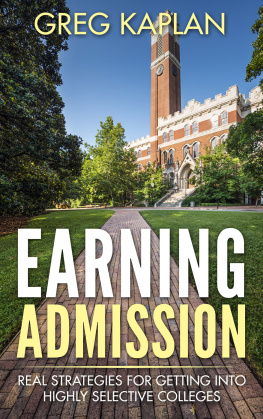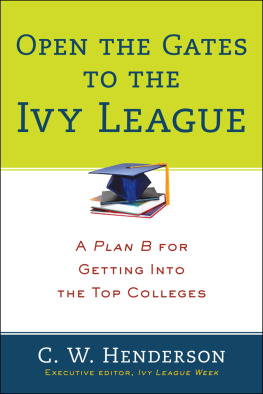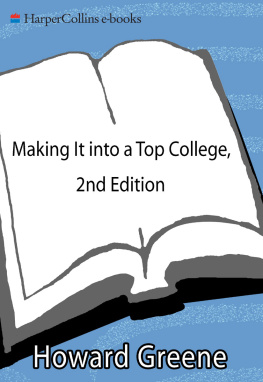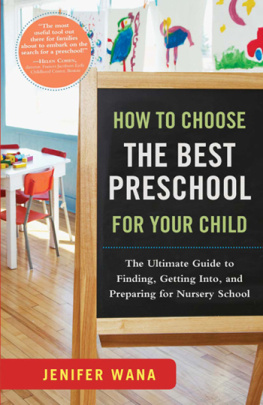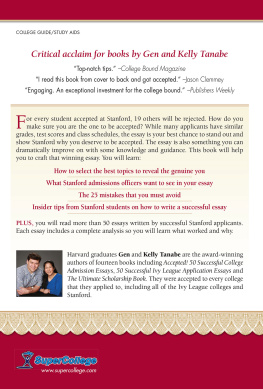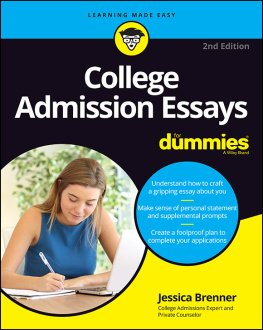All rights reserved. No part of this book may be reproduced in any form by any electronic or mechanical meansexcept in the case of brief quotations embodied in articles or reviewswithout written permission from its publisher.
All rights reserved.
To my Mom and Dad, for filling my world with inspiration.
"I never found beauty in longing for the impossible and never found the possible to be beyond my reach." Ayn Rand, Atlas Shrugged.
Introduction
I. I Will Give You the Bad News First: Earning Admission to Highly Selective Colleges Is Hyper Competitive and Biased
Applying to college has become as difficult as winning in Las Vegas. In 2015, high school seniors submitted 244,000 applications to the Ivy League. There were a little more than 14,000 spots for incoming students. That translates to 17.4 applicants for every spot. College deans and admissions officers regularly boast they could fill their entire class with valedictorians and perfect SAT scores. The 244,000 applicants are a tough crowd.
But that is not all
Applying to highly selective colleges is even worse than the math suggests. Of these 14,000 Ivy League spots, thousands go to recruited athletes, children of generous alumni, and the children of the rich, famous, and powerful. Furthermore, some of the most expensive private high schools in the country have strong ties to selective colleges and regularly send more than half of their senior class to the ivies and other selective colleges. These private schools are not that different from other high-quality high schools across the country. Students attending these schools are buying their way into college by paying $150,000 over four years to attend a high school with an existing relationship with a college or university.
Finally, some of these families hire private college admissions consultants that charge up to $25,000 to help them craft applications that admissions officers want to see. When you add up all of these applicants, there are few spots left for the rest of us.
To make matters even worse (yes, that is possible), many of the most selective colleges in the US have instituted no loan financial aid policies that provide generous grants to attract non-traditional applicants and first-generation college graduates. Many private colleges now are the same price, or even less expensive, than flagship state universities when students factor in the grants they receive. While great for the families of students admitted to these colleges, these policies are making it harder to gain admission. As elite private universities educate the public about their generous financial aid policies, the pool of college applicants continues to grow.
In addition, the number of international applicants for the same precious few spots is also skyrocketing. In 2013, 886,052 foreign students enrolled in US undergraduate and graduate programs, representing a 72% increase from 2000. 31% of these students hail from China, where competition for spots at Chinese universities is even fiercer than in the United States. Now your child is competing against an ever-increasing pool of talented students from all over the world.
The competition extends far beyond the Ivy League. Nationwide, the number of applicants to the top public and private universities continues to skyrocket. In 2014, there were 86,554 applicants for the 5,800 spots in the freshman class at UCLA. Crosstown rival USC received 51,800 applicants for 2,750 spots.
The college admissions process is even more competitive than you thought.
II. Now the Good News: Your Child Can Compete and Earn Admission with Strategy and Marketing
Unlike Las Vegas, this is not a gamblethis is your childs future. While there are no guarantees in this process, you can maximize your childs odds of gaining admission in this competitive process through strategic planning and marketing.
Planning sets your child up for success
When your child applies to college, she will have three years of grades behind her and either a SAT or ACT score. You must ensure that your childs high school transcript and entrance exam scores are competitive for the admissions process. Through planning and strategy, you can ensure that your child has the necessary grades and SAT/ACT scores to be a competitive applicant. Your child will need to take classes he will earn As in. If your child will earn an A in Spanish IV, or a B in AP Spanish if she skips Spanish IV, Don Quixote can wait one more year, and your child can maintain the grades she needs for Cornell. Planning that starts before your childs freshman year can help create the perfect transcript needed for admission.
Finding the right SAT or ACT tutor or prep program can help your child understand how these tests work and how to achieve a competitive score. The SAT and ACT favor the prepared. There are a few natural test takers out there who score incredibly well right off the bat. I was not one of them. Odds are your child, as smart as she is, is not one of them either. With hundreds of thousands of applicants, the right test prep program can make the difference between admission and rejection.
Planning alone is not enough; demonstrating and marketing your childs value to a college admissions officer will separate her from the other 200,000+ applicants.
Given the competition and preferences for recruited athletes and children of alumni and future donors, it should come as little surprise that perfect grades and SAT scores are not enough to gain admission to a selective college. At my welcome speech at Penn, the Dean boasted that Penn received enough candidates with perfect SAT scores to fill the entire freshman class.
To gain admission, your child will need to stand out from the rest of the applicants. Every essay she writes, major she selects, and activities she lists on her application are an opportunity to convince an admissions officer to admit her. Your child must use every component of the college application process to demonstrate that she will bring value to the college she wants to attendvalue that sets her apart from the other applicants. College is a time for students to discover their passions and add to the learning of other students. A demonstrated leader with a passion in a particular field may have an easier time gaining acceptance than a student that joined countless activities in high school but was unfocused. Students who can demonstrate maturity and perspective will fare better than those who come off as self-important. Said differently, every essay your child writes needs to demonstrate her ability to contribute to her dream college.
III. Demonstrate Your Childs Value to a College Admissions Officer to Earn Admission
Earning Admission is designed to teach you and your child the mindset for creating an application that stands out by anticipating what college admissions officers are looking for:
- Strong academic performance and entrance exam scores
- A cohesive theme that ties the entire application together
- Personal statements highlighting experiences or perspectives that show your childs ability to contribute value to her dream college
- Achievements in extracurricular activities that your child will continue in college.
The college admissions process is a stacked game. In Las Vegas, the house wins. Here, the favored applicants will continue to gain admission. By using strategy and marketing in your childs applications you can maximize your childs odds of earning admission. Give the admissions officer what they want to see, and your child will stand out.

